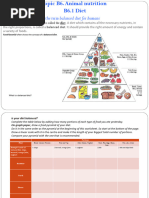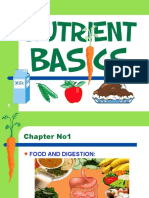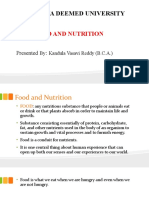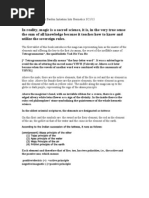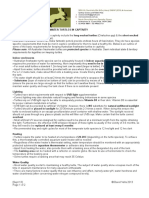Nutrients
Nutrients
Uploaded by
usama.oryxCopyright:
Available Formats
Nutrients
Nutrients
Uploaded by
usama.oryxCopyright
Available Formats
Share this document
Did you find this document useful?
Is this content inappropriate?
Copyright:
Available Formats
Nutrients
Nutrients
Uploaded by
usama.oryxCopyright:
Available Formats
2.
1 Nutrients
Everyone enjoys eating tasty food. Food gives us
pleasure. It also gives us the nutrients that we need to
stay healthy.
Nutrients are substances in food that the body uses:
• to provide energy
• to provide materials for making the chemicals that
are needed to make cells and other parts of
the body.
These foods are good sources of protein.
Different kinds of food contain different nutrients.
Protein, carbohydrate and fat
The nutrients that we need to eat in the largest
quantity are protein, carbohydrate and fat.
Protein is used for making new cells. Protein is also
used for making many important chemicals in the
body, such as enzymes (see pages 28–29) and antibodies
(see page 37). Cells can use protein to supply energy.
Carbohydrate is used to provide energy. Starch and These foods are good sources of starch
sugar are two kinds of carbohydrate. (a type of carbohydrate).
Fat also provides energy. Fat can be stored in the body.
Fat stores underneath the skin provide insulation. Fat is
needed to make new cell membranes.
Vitamins and minerals
Vitamins and minerals are nutrients that we need
in only very small quantities. They do not provide
energy. There are many different kinds of vitamins
and minerals that we need to eat. Fruit and vegetables
are a good source of some of them. There is more These foods contain a lot of fat.
information about two vitamins and two minerals on
page 20.
Fibre and water
Fibre (roughage) helps to keep food moving easily
through the digestive system. We get fibre from fresh
fruit and vegetables, and also from foods made from
whole seeds such as brown rice or wholemeal bread.
Water is sometimes considered to be a nutrient.
Between 60% and 70% of the body is made up
of water. These foods contain a lot of fibre.
18 2 Food and digestion
2.1 Nutrients
Questions
1 Explain the difference between food and nutrients.
2 The headings on the previous page contain the names of the seven kinds
of nutrients. List them all.
3 Which three nutrients provide the body with energy?
Activity 2.1
Testing foods for carbohydrates
SE Starch and sugar are two types of carbohydrate.
You can find out if a food contains starch using iodine solution.
You can find out if a food contains sugar using Benedict’s solution.
1 First, test each food for starch.
• Put a small amount of the food onto a white tile.
• Add a drop or two of iodine solution. If the iodine turns
blue-black, there is starch in the food.
2 Next, test each food for sugar.
• Chop or crush a small amount of the food,
and put it into a boiling tube. Add a little
water and stir or shake it well.
• Add enough Benedict’s solution to make the
mixture look blue.
• Put the boiling tube into a water bath at about
80 °C. Leave it for about 5 minutes.
• If there is sugar in the food, the colour will
no sugar a small a lot of
change as shown on the right.
amount sugar
3 Record your results in a results table like the one
of sugar
below. Add as many more rows as you need.
Food Colour with iodine Did it contain Colour with Did it contain
solution starch? Benedict’s sugar?
solution
Summary
• We need to eat seven different types of nutrients – protein,
carbohydrate, fat, vitamins, minerals, fibre and water.
• Different kinds of foods contain different combinations of
nutrients.
2 Food and digestion 19
You might also like
- OET B1 Progress Test Unit 7 A + BDocument11 pagesOET B1 Progress Test Unit 7 A + BЯна ПістунNo ratings yet
- Nutrition: iGCSE BiologyDocument76 pagesNutrition: iGCSE Biologyviolet paul100% (1)
- Semi-Detailed Lesson Plan in CookeryDocument25 pagesSemi-Detailed Lesson Plan in CookeryKent Bermudez75% (8)
- Contingency Plan For Drought: Quezon, PalawanDocument36 pagesContingency Plan For Drought: Quezon, PalawanDon Lanzaderas PacionesNo ratings yet
- Community Food Bank Organizational AnalysisDocument58 pagesCommunity Food Bank Organizational AnalysisRobin IsraelNo ratings yet
- Nutrients and Food TestingDocument17 pagesNutrients and Food TestingThanigaivelan A/L Arumugam [Student]No ratings yet
- Food TestsDocument21 pagesFood TestskfrancisNo ratings yet
- NUTRITION AND FOOD TESTSDocument23 pagesNUTRITION AND FOOD TESTSswathy21pandiyanNo ratings yet
- VitaminsDocument8 pagesVitaminsrzalivahid6No ratings yet
- Capter 1ppt on Components of FoodDocument16 pagesCapter 1ppt on Components of FoodshivanadgdNo ratings yet
- FoodDocument32 pagesFoodrungarunchanyoungNo ratings yet
- Topic B6.. Animal Nutrition B6.1_modifiedDocument21 pagesTopic B6.. Animal Nutrition B6.1_modifiedCrystalNo ratings yet
- Diet and Growth (Part 1)Document8 pagesDiet and Growth (Part 1)Kenzy HassanNo ratings yet
- NutrientsDocument40 pagesNutrientsOmar FaourNo ratings yet
- Class 6 Science Lesson 1 Components of FoodDocument13 pagesClass 6 Science Lesson 1 Components of Foodapplogin27No ratings yet
- Unit 8A Food and Digestion: Name: .Document14 pagesUnit 8A Food and Digestion: Name: .rickyNo ratings yet
- 20240504124948IIS A C1b563c7337c0b51.class6bio Compof-Food QuestionandAnswerDocument3 pages20240504124948IIS A C1b563c7337c0b51.class6bio Compof-Food QuestionandAnswerabelshibu2007No ratings yet
- FST01 Unit 21 To 30Document151 pagesFST01 Unit 21 To 30sumit prajapatiNo ratings yet
- Unit 21 Food and Nutrition: StructureDocument16 pagesUnit 21 Food and Nutrition: StructureanonymousNo ratings yet
- Choosing Healthful FoodDocument8 pagesChoosing Healthful Foodshivendra.prakashNo ratings yet
- Screenshot 2021-04-20 at 12.43.16Document56 pagesScreenshot 2021-04-20 at 12.43.16MichaelNo ratings yet
- Lamb Chop Biscuits Chocolate Bar Peanut Oil Cream FishDocument69 pagesLamb Chop Biscuits Chocolate Bar Peanut Oil Cream FishCt Rahmah50% (2)
- 6. Grade 4-Being HealthyDocument24 pages6. Grade 4-Being Healthyajmerbhavesh6208No ratings yet
- 8aa NutritionDocument29 pages8aa NutritionmaryamNo ratings yet
- Balanced DietDocument35 pagesBalanced DietOmar FaourNo ratings yet
- FOOD FOR HEALTHDocument6 pagesFOOD FOR HEALTHmomireema10No ratings yet
- Components of Food - Class 6, Components of FoodDocument10 pagesComponents of Food - Class 6, Components of FoodPriyaNo ratings yet
- Green and Beige Illustrative Healthy Food PresentationDocument8 pagesGreen and Beige Illustrative Healthy Food Presentationak909713No ratings yet
- Chapter 1 - Food and Digestion NotesDocument16 pagesChapter 1 - Food and Digestion NotesHailey CaruanaNo ratings yet
- Components of FoodDocument5 pagesComponents of Foodsyedrehnuma187No ratings yet
- Unit 1 - Foo-WPS OfficeDocument29 pagesUnit 1 - Foo-WPS OfficeKatirin CastroNo ratings yet
- 8A NutrienDocument17 pages8A NutrienAron ProxyNo ratings yet
- Components FoodDocument4 pagesComponents FoodPizza BoyNo ratings yet
- Components of food class 6Document2 pagesComponents of food class 6Anubhav SinghNo ratings yet
- Food and DigestionDocument51 pagesFood and Digestionshahbaz saahilNo ratings yet
- Food & Nutrition: Indian Hills Middle SchoolDocument15 pagesFood & Nutrition: Indian Hills Middle SchoolAlfie DilagNo ratings yet
- WEEK 1Document11 pagesWEEK 1jeffreyeguaoje5No ratings yet
- Igcse NutritionDocument125 pagesIgcse NutritionLai Kee Kong100% (2)
- Content PPT Course 111 IntelDocument52 pagesContent PPT Course 111 Intelzahabia k.bNo ratings yet
- Health and Lifestyle Whole Unit PowerpointDocument133 pagesHealth and Lifestyle Whole Unit Powerpointmyriam.johnNo ratings yet
- Anju ShinuDocument16 pagesAnju ShinuANJU C RNo ratings yet
- Components of Food Q&A Work Done Today 13th May PDFDocument44 pagesComponents of Food Q&A Work Done Today 13th May PDFPradeepKanwarNo ratings yet
- NutritionDocument16 pagesNutritionLeona KokeraiNo ratings yet
- Shaniel Richards Biology Food Test Lab 2Document3 pagesShaniel Richards Biology Food Test Lab 2Shaniel richardsNo ratings yet
- Ch.3 Food, Nutrition, Health & FitnessDocument14 pagesCh.3 Food, Nutrition, Health & FitnessSimar SinghNo ratings yet
- 5.1 Food and Health 2023Document14 pages5.1 Food and Health 2023Aya Osman 7KNo ratings yet
- Sugars, Proteins and Lipids in Food SamplesDocument15 pagesSugars, Proteins and Lipids in Food SamplesSamuel ChuaNo ratings yet
- Handout 2.3Document4 pagesHandout 2.3Behraz FareedNo ratings yet
- Chaitanya Deemed University: Food and NutritionDocument14 pagesChaitanya Deemed University: Food and NutritionVenkatasairamreddy KandulaNo ratings yet
- Food and Digestion BookletDocument10 pagesFood and Digestion BookletOzum Naz BaturNo ratings yet
- Le - 2. Components of FoodDocument9 pagesLe - 2. Components of Foodsuhasdino02No ratings yet
- FoodDocument16 pagesFoodArun kumar TripuraNo ratings yet
- CH 4 - A Healthy DietDocument16 pagesCH 4 - A Healthy Diethellen.kayyrrNo ratings yet
- Categories of NutrientsDocument57 pagesCategories of Nutrientsalanatricia puzonNo ratings yet
- Chapter 2 Form 5 ScienceDocument9 pagesChapter 2 Form 5 ScienceSensei J-dai91% (35)
- L1 8Aa Nutrients AAFDocument15 pagesL1 8Aa Nutrients AAFintuitiveclock4No ratings yet
- Components of FoodDocument8 pagesComponents of Foodsaryumba5538100% (1)
- Raw Food Detox: Revitalize and rejuvenate with these delicious low-calorie recipes to help you lose weight and improve your energy levelsFrom EverandRaw Food Detox: Revitalize and rejuvenate with these delicious low-calorie recipes to help you lose weight and improve your energy levelsNo ratings yet
- Low Carb High Protein Cookbook: Irresistible and Healthy Low-Carb, High-Protein Recipes to Fuel Your Day: Low Carb Recipes For 2023, #1From EverandLow Carb High Protein Cookbook: Irresistible and Healthy Low-Carb, High-Protein Recipes to Fuel Your Day: Low Carb Recipes For 2023, #1No ratings yet
- Healty DietDocument11 pagesHealty DietmarkoNo ratings yet
- How To Survive An Economic CollapseDocument12 pagesHow To Survive An Economic CollapseDoug TerrellNo ratings yet
- ProgramDocument54 pagesProgramZita Nemet SeresNo ratings yet
- Free Food Safety VideosDocument16 pagesFree Food Safety VideosMuhammad AtifNo ratings yet
- Restaurant Name: Good QualitiesDocument2 pagesRestaurant Name: Good QualitiesXyeda SaraNo ratings yet
- JF Preparation of Food and Drink Text enDocument39 pagesJF Preparation of Food and Drink Text enTakumi Japanese100% (1)
- VII CLASS General Science Notes (Byju's)Document66 pagesVII CLASS General Science Notes (Byju's)SSR CreationsNo ratings yet
- Synopsis Format InfromationDocument4 pagesSynopsis Format InfromationMohit SinghNo ratings yet
- Natural Remedies For GoutDocument9 pagesNatural Remedies For Goutrichele valencia100% (1)
- L 19 Harmony in Nature v3Document33 pagesL 19 Harmony in Nature v3Devank KhutetaNo ratings yet
- Potential of Honey Production and Its Utilization For Food Security in Filtu Woreda, Liben Zone, Somali Regional State, EthiopiaDocument4 pagesPotential of Honey Production and Its Utilization For Food Security in Filtu Woreda, Liben Zone, Somali Regional State, Ethiopiaabraha gebruNo ratings yet
- New Notes On Franz Bardon Initiation Into Hermetics 3Document7 pagesNew Notes On Franz Bardon Initiation Into Hermetics 3Violet76100% (2)
- Complete Download Animal Nutrition 8th Edition P. Mcdonald PDF All ChaptersDocument50 pagesComplete Download Animal Nutrition 8th Edition P. Mcdonald PDF All Chaptersreannbrihmj7100% (1)
- Title Project Proposal On Edible Oil ProDocument29 pagesTitle Project Proposal On Edible Oil ProMedard SottaNo ratings yet
- Feeding Relationships in An Ecosystem: IGCSE BiologyDocument10 pagesFeeding Relationships in An Ecosystem: IGCSE BiologyTharanga HewabuhageNo ratings yet
- Case 1 Kelloggs - Using New Product Development To Grow A BrandDocument4 pagesCase 1 Kelloggs - Using New Product Development To Grow A BrandJackyHoNo ratings yet
- Water Quality of Turtle 01Document2 pagesWater Quality of Turtle 01Lyssandra FerreiraNo ratings yet
- Rethinking Food and Agriculture 2020-2030Document16 pagesRethinking Food and Agriculture 2020-2030Carlo NúñezNo ratings yet
- Evolution PNP CardsDocument19 pagesEvolution PNP Cardssulaco1260No ratings yet
- Retamal Project 2 Correct VersionDocument6 pagesRetamal Project 2 Correct Versionapi-253205398No ratings yet
- Chemistry Class 12 Project Adulteration of Food MaterialsDocument19 pagesChemistry Class 12 Project Adulteration of Food MaterialsSiddhartha GautamaNo ratings yet
- Local Vegetable Food Kaikai Recipe in Solomon-IslandsDocument69 pagesLocal Vegetable Food Kaikai Recipe in Solomon-IslandsJacNo ratings yet
- High Risk Foods and Textures: A Guide For Patients With Dysphagia AboutDocument2 pagesHigh Risk Foods and Textures: A Guide For Patients With Dysphagia AboutGelo SobrepeñaNo ratings yet
- Nutrition: Lesson 1Document20 pagesNutrition: Lesson 1FerryVernandoNo ratings yet
- Haccp For Irish Beef, Pork and Lamb Slaughter: AuthorsDocument16 pagesHaccp For Irish Beef, Pork and Lamb Slaughter: Authorspopa.janossNo ratings yet











